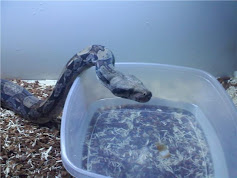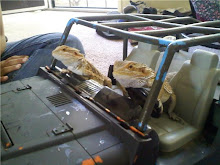
Corn snakes (Elaphe guttatus) or red rat snakes are one of the best beginner snakes to own. They are active, unlike many pythons and boas, and don’t get too large. They are mostly active at dawn or dusk. Corn snakes are related to the rat snake, and they have much of the same care.
Corn snakes got their name because they were discovered in cornfields. At first farmers thought they ate the corn, but like most snakes, they eat mice and frogs. These snakes are found in the southern half of the US and Mexico. They are known to be able to thrive in nearly any environment such as field, forests, and farm areas.
Appearance
Corn snakes will grow an average of 3-5 feet long. After the many years of breeding corn snakes, there are many colors and variations of patterns. Baby corn snakes start out at about 10-14 inches long.
If you do purchase one, you must keep in mind that they will live up to 20 years if you provide the right care. Be sure you are prepared for this.
These snakes are slender, and do not grow thick around like the ball python. This makes them faster, and they never seem to get tired.
Handling/Aggression
When you first purchase a corn snake, they may try to escape your grasp when you are holding it. If you feel they are too nervous to be handled, once a day you can set your hand in the tank near the snake. Your snake will learn your scent, and will adjust.
Do not be surprised if babies nip you. This is simply their way of defense, and it shouldn’t hurt. Let them learn slowly that you mean no harm. In the long run, it pays off. When tame, adults can be handled and will not mind at all. Be sure to keep them in your sight or else they will slither away. Tame corn snakes will not bite if you respect them.
Feeding
There have been some debates about feeding frozen/ thawed or live mice. Frozen/thawed seems to be the why of the new generation of reptile keepers for many reasons. Frozen/thawed (f/t) is much more humane. It is simply a quick blow to the head.
The main reason why f/t is better is because a live mouse will defend itself by biting your corn snake. This can injure the snake, and the mouse or rat could even kill because there is nowhere to run in a tank.
Feeding the right sized food items is very important. If a snake is given something to eat that is over sized, it will regurgitate. If you give too small of a food item, they will be hungry. A popular rule is to give your snake a rodent that is about the width of its body.
Hatchling corn snakes will eat about two times a week, but some corn snake keepers get away with one and their snakes are fine. Adults can be fed every 7-10 days.
Once a snake has eaten, it should not be held until at least 48 hours after they eat. If you do, it could also result in regurgitation.
Housing Requirements
Housing a corn snake is fairly simple, and they do not take up much space. A 10 gallon tank is good for hatchling and juvenile snakes, but adults need a minimum of 20 gallons. The bigger the tank, the happier your snake will be. A bigger tank is not better for hatchling or else they could get lost.
Something that cannot be stressed enough is to have a secure lid. Corn snakes along with most other snakes are natural escape artists. You should have a lid that is either clipped or locked to the tank so they don’t get out.
Corn snakes are semi arboreal, so provide a climbing branch in the tank. If you take one from outside, bake it in an oven at 300F for 15 minutes. Drift wood pieces can be bought at most pet stores.
If you move around the stuff in the tank once in a while, it will give your corn snake something new to explore.
Substrate
There are many things that can be used as a substrate, some of the most basic ones being butcher paper, newspaper or paper towels. They can all be replaced easily and are cheap. They are not the best-looking substrates however. Although these should be used for hatchlings, you can also use wood chips.
The number one rule with wood chips is No Cedar. Cedar, if and when swallowed will kill a snake because it is toxic. This goes for any snake. Another wood that is not a good idea is pine. Pine can give off unhealthy fumes.
Instead of what was mentioned above, reptile chips and aspen shavings work well. They are good looking and safe. Make sure that you do not use sand or soil because your snake can become impacted.
Shelter
Corn snakes will want to rest during the day, so it is a good idea to provide a hide box or two. These hide boxes should be nice and snug for the corn snake to curl up in, but not so tight that they are uncomfortable.
Some cheap and easy ideas are macaroni and cheese boxes cut to the appropriate size, or a plastic object like an empty butter container.
Temperature
Reptiles are cold blooded, so a heat source is a must. Under tank heaters (UTH) work okay, but an overhead lamp, especially if you have paper towel substrate is better. Corn snakes need the air temperature in the basking spot to be 85F. On the other side of the tank, it should be about room temperature.
It is important to provide a thermal gradient because corn snakes naturally will find a colder spot if they want to cool down and vice versa. Since corn snakes are not active during the day, so UV bulbs are not needed.
Water/Humidity
Corn snakes need a large and sturdy water bowl. They will use it right before a shed, and sometimes just because they feel like it. Corn snakes are also well known to “take a dump” in the water bowl, so clean it as needed.
There is no need to mist your corn snake’s tank because they will use the water bowl.
Cleaning
A corn snake’s cage won’t take any more that 10 minutes a day to clean. Since they go to the bathroom in their water bowl, make sure that stays clean at all times. Your corn snake will appreciate it.
Other than the water bowl, just be sure to spot clean when necessary.
Breeding
Breeding corn snakes can be a very rewarding experience. The main conflict and argument with breeders is whether to have them hibernate or not. If you decide to, give each snake a sweater box with a newspaper substrate, a water bowl and a hide box.
They should then be put in a basement where they are kept at 55-60F until April or May. If you decide not to have them go into hibernation, make sure that you make each day of sunlight shorter in the room. Many breeders have had success with this method.
You should breed corn snakes in June. After a month or two, you should receive anywhere from 8-20 eggs. Most of the time a female will average 10-12 eggs.
Once the eggs arrive, place them in an incubator at 80-85F. It will take them 80-90 days to hatch. The incubator should be kept from 80-100% humidity.
This should not be the only care sheet you look at on how to breed corn snakes. Different people have different opinions, and you should find which way you like most.
Hatchling Care
Corn snake hatchlings can kept with three or four per ten gallons. As they get older, you should provide them with their own 10 gallons and when adults, 20 gallons. Their substrate should be paper towels, because it is the easiest way to monitor how they are doing and so they won’t swallow any wood chips or shavings.
Hatchlings can be started off with a pinkie mouse once or twice a week. As they get thicker provide them with bigger food items.
Conclusion
Corn snakes are hardy, active, and enjoyable pets to own. Their care isn’t that hard. If you have the time, the money, and the right care, you can watch your corn snake thrive.
Boa.jpg)



No comments:
Post a Comment